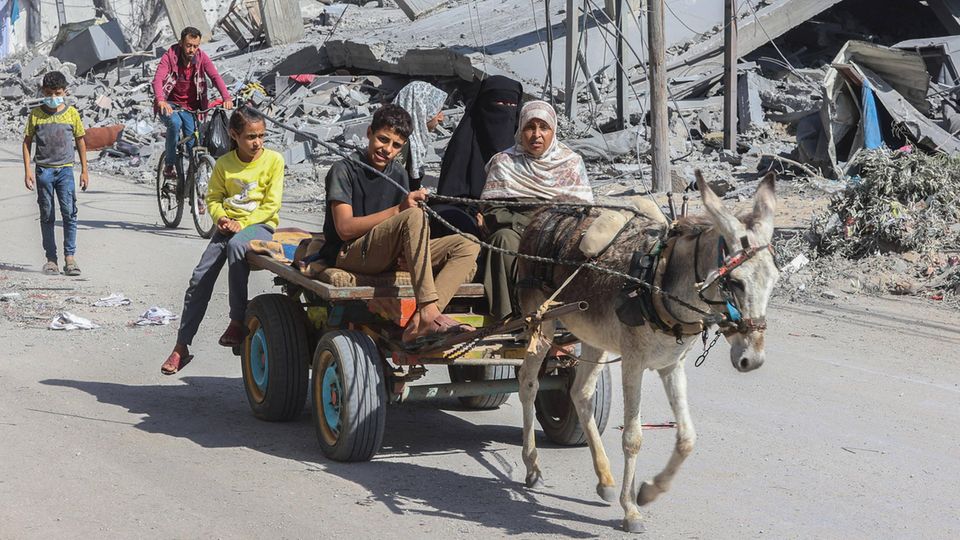questions and answers
If Israel’s ground offensive in Rafah comes, where will the people go?
After Israeli attacks on the city of Rafah, people examine the rubble left behind
© Yasser Qudih / XinHua / DPA
The city of Rafah in the southern Gaza Strip has been a refuge for thousands of people in the coastal strip since October 7th. But now Israel wants to invade there too. What’s next for the refugees there?
Israel wants its military operation on the city Expand Rafah on the border with Egypt. More than a million Palestinians have sought refuge there from the offensive that has devastated much of the Gaza Strip. In recent days, Israel has already attacked the city in the south of the coastal area from the air.
Why is Israel planning a ground offensive in Rafah?
Israeli Prime Minister Benjamin Netanyahu has described Rafah as the “last bastion” of the radical Islamic group Hamas, where four armed “battalions” are said to be based. According to the common definition, battalions are military units that can have between a few hundred and more than a thousand members. According to Netanyahu, Israel cannot achieve its goal of eliminating Hamas as long as its fighting groups are in Rafah.
After Hamas’s attack on Israel on October 7, 2023, in which around 1,200 people were killed and more than 200 were kidnapped as hostages in the Gaza Strip, Netanyahu set the goal of destroying Hamas. The Israeli military has already combed most of the Gaza Strip. According to the Palestinian health authorities, around 28,000 people were killed and tens of thousands more injured in the Hamas-ruled Gaza Strip.
What is the situation in Rafah?
According to the UN agency UNRWA, which supplies the Palestinians with aid, among other things, around 1.5 million people currently live in Rafah. That’s six times more than before October 7th. Many of them camp on the streets, in vacant lots, on the beach and on the sandy strip next to the border wall with Egypt. Others are housed in overcrowded accommodation. Doctors and aid workers struggle to provide even the most basic help and prevent the spread of disease. The Norwegian Refugee Council describes the area as a “gigantic refugee camp.” A doctor who recently left Gaza called Rafah a “closed prison.” The streets, where feces are omnipresent, are so overcrowded that vehicles carrying paramedics, for example, can hardly get through.
Where could the people of Rafah flee to?
Before previous attacks on cities in the Gaza Strip, Israel urged civilians to flee south. Many of the displaced people therefore ended up in Rafah. People can’t go much further south because that’s where the border with Egypt is. Netanyahu’s office said the army had been ordered to develop a plan to evacuate Rafah. Aid organizations and numerous representatives of foreign states who strictly reject Israel’s actions have said that people can no longer go anywhere in the coastal strip.
The area, which is approximately 40 kilometers long and between six and 14 kilometers wide, borders Israel to the north and east, Egypt to the south and the Mediterranean to the west. According to estimates, around 2.3 million people live there. The Gaza Strip is one of the most densely populated areas in the world. By far the largest part of the housing and infrastructure was destroyed in the Israeli offensive in recent weeks. Netanyahu does not want to let the refugees into Israeli territory. And Egypt has declared that it will not allow Palestinian refugees to cross the border.
Why doesn’t Egypt want to let the Palestinians into the country?
Egypt is in an economic crisis. There are already more than half a million refugees from dozens of nations living in the country. It would also be unclear whether Israel would allow the Palestinians to return from Egypt to the Gaza Strip at some point – or whether there would be other permanent refugee camps in Egypt whose people would have to be cared for for decades. Egypt also fears that Hamas fighters could enter the country, join forces with government opponents and carry out attacks.
Offensive also to prevent a two-state solution?
Shortly after the start of the Israeli offensive, Arab countries – especially Israel’s neighbors Egypt and Jordan – declared that the Palestinians should not be expelled from the country where they want to establish a future state. This would include the West Bank and the Gaza Strip. There are concerns that any mass exodus across the border would further undermine the prospects for a “two-state solution” – the idea of creating a state of Palestine alongside Israel – and leave Arab nations confronted with the consequences. Philippe Lazzarini, head of the UN relief agency UNRWA, had already written in the Los Angeles Times at the beginning of December that the developments he was observing indicated that attempts were being made to bring Palestinians to Egypt.
What speaks against leaving the Gaza Strip?
Many Palestinians have said they would not leave the Gaza Strip even if given the chance. They fear that this could lead to further permanent displacement, as they believe was the case in 1948. At that time, around 700,000 Palestinians left their homeland when Israel was founded. From Israel’s perspective, these were not expulsions at the time. However, many describe themselves as displaced persons and have fled to neighboring Arab states such as Jordan, Syria and Lebanon. Many of these people or their descendants still live in refugee camps.




